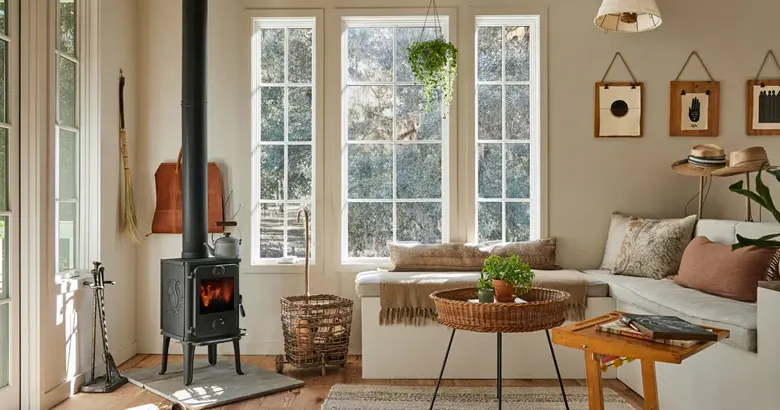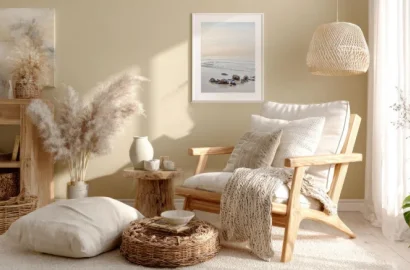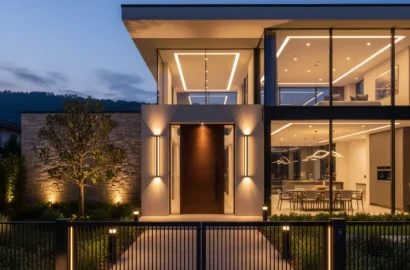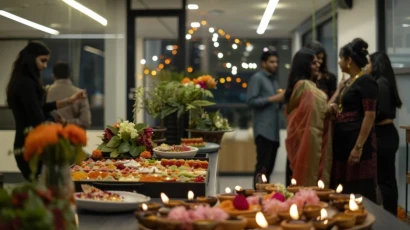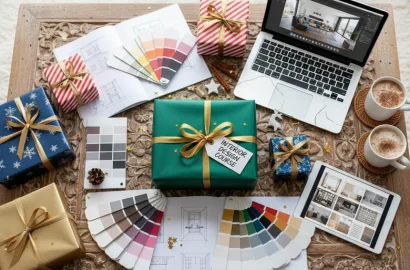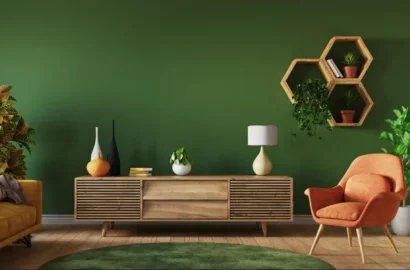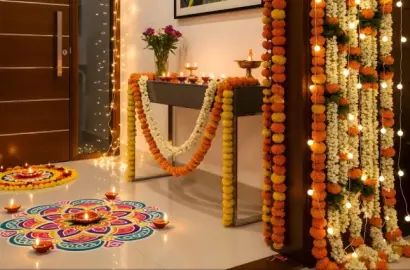Learn everything about Scandinavian interior design, from its history and essential features to its types. Also, find out more about the latest trends shaping this popular style.
Scandinavian interior design is admired for the simplicity, functionality, and comfort it brings to a space. A staple in Nordic homes and beloved worldwide, this timeless design style offers versatility as well as aesthetic appeal, making it a go-to choice for effortlessly elegant interiors. If you’re curious about the do’s and don’ts of this interior design style and want to learn how to make the most of it, you’ve come to the right place.
In this comprehensive guide, we cover the basics of Scandinavian interior design, understand what makes it so popular and relevant even today, and explore essential features and practical ideas to help you incorporate this style into your designs or homes.
Whether you’re incorporating a brand new look for your homes or upcoming projects or just browsing for new ideas, we hope to give you some inspiration.
Here’s a clickable list of everything that we’ll be covering in this article!
- What is Scandinavian interior design?
- Brief history of Scandinavian interior design
- Types of Scandinavian interior design
- Typical characteristics of Scandinavian interior design
- Scandinavian interior design trends to consider
- Conclusion and next steps
What is Scandinavian interior design?
Scandinavian interior design, much like its Japanese counterpart, is a variety of the minimalist style that follows the ideology of “less is more.” Within these styles, spaces are typically characterized by clean lines, a neutral color scheme, thoughtful organization, and pared-down ornamentation that focuses on comfort and practicality.
Originating in the Nordic countries, Scandinavian design prioritizes light, airy spaces that connect with nature. It incorporates abundant natural light, sustainable furnishings, and natural materials, establishing calm, cozy, and uncluttered environments. The style also embraces "hygge," a Danish concept centered on comfort and well-being, which further enriches the living spaces.

Why is it popular?
Scandinavian design has gained worldwide popularity due to its perfect balance of simplicity, functionality, and love for aesthetics—all of which resonate with modern lifestyles. Here’s why it continues to resonate with people across the globe:
- People looking to declutter appreciate the balance between visual appeal and practicality, especially in smaller urban spaces where storage solutions and efficient use of space are important.
- The emphasis on natural light, neutral tones, and minimal decor creates a soothing environment, ideal for those seeking calm and organized living spaces.
- With more people working from home, the light and airy feel of Scandinavian interiors adapts to modern lifestyles, creating a bright and uplifting space that combats long, dark winters and supports extended indoor routines.
- The use of natural and durable materials such as wood, linen, and stone aligns with the growing demand for sustainable living. Scandinavian design promotes quality over quantity, making it a favorite among environmentally conscious consumers.
- The global shift toward minimalism has further propelled the appeal of Scandinavian design. Its timeless, adaptable nature allows homeowners to refresh their spaces without constantly chasing new trends.
Brief history of Scandinavian interior design

Image Courtesy: Architectural Digest
Scandinavian design has deep roots in the culture and lifestyles of the Nordic countries such as Denmark, Sweden, Norway, Finland, and Iceland. The design style we recognize today began to take shape in the 1950s, alongside the broader modernist movement in Europe and the U.S. Scandinavian modernism that was focused on creating affordable, functional, and democratic interiors.
While clean lines, minimalism, and neutral colors were common traits in modernist design across the globe, Scandinavian design was also influenced by the region's long, cold winters. This led to a design philosophy that balanced simplicity with warmth, aiming to create cozy yet bright spaces that felt welcoming even during the darkest days.
Today, Scandinavian interior design continues to evolve while retaining its original principles—making it an enduring favorite in homes across the world.
Types of Scandinavian interior design
Before we move ahead with the features of Scandinavian design, let’s understand its types.
1. Japanese Scandinavian Design

Image Courtesy: The Spruce
Japanese Scandinavian design, better known as Japandi, is a style that combines the pared-down Scandinavian aesthetic with the comfort of Japanese minimalism. The style typically features clean lines, natural materials, and neutral colors, creating a distinctive style that captures the essence of both design philosophies. It also includes low-profile furniture, natural woods in contrasting tones, and curated decorative elements that feel organized and effortlessly stylish.
2. Traditional Scandinavian Design

Image Courtesy: The Architect’s Dairy
Traditional Scandinavian design embodies the core principles that emerged in the 1950s Nordic design movement, emphasizing functionality, the use of light woods, and a predominantly white color palette with subtle pastels. This style is known for its classic pieces like wishbone chairs, simple teak furniture, and traditional textiles with geometric patterns. It also incorporates folk elements through hand-crafted items, patterns, and vintage elements, resulting in a space that narrates stories of impeccable craftsmanship and timeless elegance.
3. Modern Scandinavian Design

Image Courtesy: Sewing House
Modern Scandinavian design builds upon traditional principles while adapting to modern design needs. It features furniture with clean silhouettes and dynamic color choices—think soft pinks, sage greens, or dusty blues, complementing the classic white backdrop. This style often incorporates bold geometric patterns, contemporary art, and innovative lighting designs while emphasizing functionality and natural light.
4. Industrial Scandinavian Design

Image Courtesy: Prestige Affairs Furniture
Industrial Scandinavian design is a striking fusion of Nordic modernism and raw, industrial materials. Exposed brick, steel, concrete surfaces, and metal fixtures create an edgy foundation, while light woods, soft textiles, and an abundance of natural light soften the harsher industrial elements, creating a space that’s rugged as well as inviting. The color palette leans toward grays and blacks, balanced by wooden and leather accents. The furniture blends industrial material with Scandinavian design—metal-framed chairs with wooden seats or concrete coffee tables with organic shapes, offering a retro vibe with lasting comfort.
5. Rustic Scandinavian Design

Image Courtesy: The Nordroom
Rustic Scandinavian design is a colloquial style that highlights a deep connection to nature while reflecting an old-world charm. This style features the use of unfinished or weathered woods, natural stone, exposed beams, vintage furniture, and textured elements like rough linens and handwoven textiles. The color palette draws inspiration from earthy tones such as forest green, bark brown, and stone gray while retaining the bright, airy feel that’s typical of Scandinavian interiors. Decorative accents include vintage farm tools, hand-carved wooden objects, and botanical elements, creating a cozy, cabin-like ambiance without compromising the simplicity and functionality that define Scandinavian design.
Typical characteristics of Scandinavian interior design
Several characteristics fundamentally shape, influence, and define Scandinavian interior design. Let’s take a look at these and understand their importance.
1. Whites and a neutral color scheme
The thumb rule of the Scandinavian style is the use of whites and neutral tones. The preference for softer colors helps brighten spaces, which is essential in regions with long winters and limited daylight. To create a quintessential Scandinavian interior, consider white walls complemented by soft pastels in your decor items. The bright, airy feel promotes a sense of well-being, creating an inviting atmosphere even in darker months.
2. Plenty of natural light
Large windows, open layouts, and minimal window treatments are common practices to maximize sunlight. This focus on natural light not only helps combat the long, dark winters but also contributes to the overall feeling of openness and comfort in Scandinavian homes.

3. Clean lines
The clean lines of Scandinavian design align closely with mid-century modern aesthetics. Both styles share a minimalist approach, emphasizing functionality and form. These interiors typically feature sleek, unadorned furniture with natural hues, reflecting a balance of simplicity and comfort. This means designing an organized and uncluttered space with furniture that has softer and comfier shapes. To understand this visually, imagine a room with plenty of breathing space and furniture that doesn’t have too many frills or details.
4. Natural materials
Another popular characteristic is the use of plenty of natural materials, including wood, stone, and brick, all of which are foundational to Scandinavian interiors. These materials bring texture and warmth to spaces, offering a connection to nature. Common examples include natural wood flooring, exposed beams, and whitewashed brick walls, which create a neutral and organic base that enhances the minimalist aesthetic.
4. Bringing nature indoors
The Scandinavian style values nature, so adding succulents and indoor plants is a given to ensure that your space feels fresh and lively. This can be seen in the abundance of plants, raw wood accents, and natural textiles, all of which help to create a connection between indoor and outdoor environments.

5. Warm and cozy textiles
Despite the minimalist furniture and neutral color scheme, Scandinavian interiors embrace warmth through textiles. Cozy throws, wool rugs, and plush cushions soften the space, making it inviting and comfortable. These textiles not only add visual interest but also promote the cozy, hygge-inspired atmosphere that is central to Scandinavian living.
6. Using storage as decor
Organized storage solutions, also an essential decor element ensure you have designated spaces for keeping away your things, like built-in shelves, cabinets, and drawers. This helps reduce clutter, making the space look neat and well-organized, in turn, maximizing functionality, a fundamental aspect of an ideal Scandinavian interior design.
8 Scandinavian interior design trends to consider
Trends can often clarify abstract concepts, making it easier to understand the practical application of Scandinavian interior design in different areas of your home. On that note, we bring the latest trends using which you can customize this style to your space and also make informed decisions regarding colors, furniture, decor, and organization.
1. Prioritize comfort
In 2025, comfort will take the spotlight in Scandinavian interior design. Expect to see plush sofas, cozy armchairs, soft poufs, and multifunctional daybeds—creating spaces that bring in warmth and relaxation. This trend marks a shift toward a more mindful approach to design, where every material and color choice is intentional, prioritizing physical and emotional well-being. Above all, the core aesthetic remains deeply personal and reflects one’s unique personality and preferences.
2. Incorporate multi-functional furniture
Multi-functional and modular furniture serves more than one purpose, allowing homeowners to make efficient use of spaces without feeling cramped. Sofa-cum beds, beds with built-in storage, and coffee tables that double as ottomans or desks are some examples. The usage of such furniture creates flexible design solutions, such as hidden compartments, fold-out components, or adjustable furniture that reduce visual clutter. Scandinavian interiors also prioritize comfort and embrace deep cushions and body-embracing shapes when it comes to furniture, allowing you to interact in your intimate zone.

3. Scandinavian Japandi fusion
As we have seen, Japandi, a fusion of Japanese and Scandinavian design, combines the Japanese principles of slow living and simplicity with the Scandinavian focus on coziness and well-being. In 2025, this hybrid style is set to gain even more popularity. Expect to see a harmonious blend of Scandinavian elements like clean lines and neutral color palettes alongside Japanese-inspired features such as low-profile furniture and decorative stone pieces. This combination creates spaces that are both serene and functional, offering a perfect balance of style and comfort.

4. Embrace nostalgia
Scandinavian interior design trends for 2025 are centered around revisiting heritage and nostalgia, giving new identity to iconic creations from the past. Craft traditions are being rediscovered, classic pieces are reissued in updated colors and materials, and exclusive limited editions are bringing retro charm back to the forefront.
This revival speaks to a longing for familiarity and comfort, especially in uncertain times. Expect a resurgence of designs from the 60s, 70s, and 80s, reimagined with a modern Scandinavian twist that blends functionality, simplicity, and timeless aesthetic.
5. Tactility & material contrasts
In 2025, Scandinavian design embraces a trend focused on tactile materials and unexpected material contrasts. Velvet makes a bold return, adding a touch of retro luxury, while natural woods like burl and pine are revived to bring warmth, depth, and character. This fusion of smooth and textured elements creates a multi-sensory experience, adding a rich, lived-in feel to interiors. The trend highlights a desire for sensory comfort and a deeper connection to nature, making spaces not only visually appealing but also engaging to the senses.
6. Curved furniture
Curved furniture is another rising trend in 2025. This softer, more organic alternative to traditional straight-edged pieces adds warmth and comfort, creating a natural flow throughout the room. From curved sofas and armchairs to oval coffee tables and rounded sideboards, these pieces can be great options. The curves balance the harsh angles of door frames, windows, and other furniture items, typical of Nordic homes.
To incorporate curved furniture into your space, opt for soft, plush upholstery in neutral shades like beige or pastel tones, making your homes comfortable and inviting for socializing.

7. Concept of maximalism
Maximalism is gaining momentum, with bold patterns, vibrant colors, and folk craft influences creating a more eclectic style. While Scandinavian design is typically known for its minimalist, neutral tones, the trend is shifting in 2025 to incorporate maximalist wall art such as abstract paintings, graphic prints, or large-scale photography. These striking pieces add a bold contrast and warmth, enriching neutral Scandinavian spaces with visual excitement. To bring this approach into your own space, balance the bold artwork with natural materials, layered textures, and simple, functional furniture.
8. Bold color accents
While Scandinavian interior design is traditionally known for its neutral tones, bold color accents are gradually making their place within this style. Scandinavian chic is evolving to embrace vibrant pops of rich, saturated hues alongside the usual soft, muted shades, adding energy and vibrancy to interiors.
In 2025, colors like deep blues, fiery oranges, mustard yellows, and emerald greens are trending, especially in statement accessories like chairs, rugs, or throw pillows. However, to maintain the clean, uncluttered aesthetic that defines Scandinavian design, it’s best to incorporate bold colors thoughtfully. Opt for one or two standout pieces to create an impactful yet balanced look rather than overwhelming the space.

Conclusion
With that, we come to the end of this holistic guide. All in all, this in-vogue interior design style is a simple one to go with if you’re looking for a tidy aesthetic paired with comfort. Whether you’re looking for a small upgrade to your current design or doing a complete renovation, always try to focus on balance. Incorporating a few trends that work well against a neutral backdrop can be effective in achieving your desired aesthetic.
We hope that this guide has helped you understand the nuances of this interior design style and its profound impact, as well as inspired you to incorporate the latest trends into your projects or homes.
If you’d like to learn more about Scandinavian interior design, head back over to the AND Academy blog for more articles like this one. We also recommend you check out this project by AND Learner, Sunali Khajuaria to get inspiration for your next interior design project.
Next Steps
In case you need further assistance, here are some resources to consider:
- Watch this session by Snehanshu Mukherjee, Founding Partner at T.E.A.M and Mansi Almadi, an Interior Designer at Studio Lotus
- Talk to a course advisor to discuss how you can transform your career with one of our courses.
- Check out our Interior Design courses - all courses are taught through live, interactive classes by industry experts.
- Take advantage of our scholarship and funding options to overcome any financial hurdle on the path of your career transformation.
Note: All information and/or data from external sources is believed to be accurate as of the date of publication.

